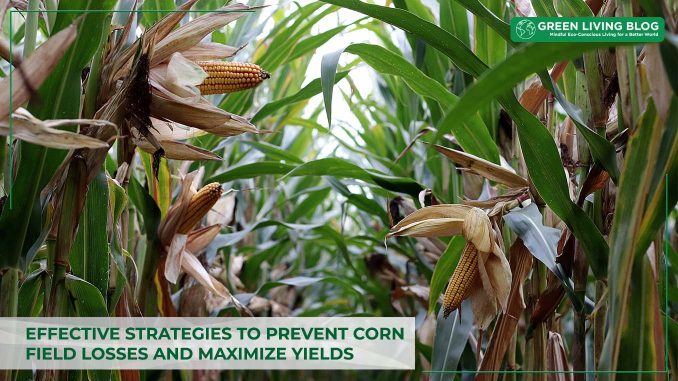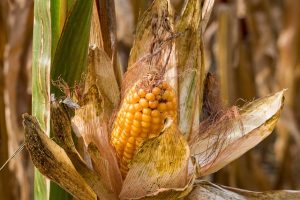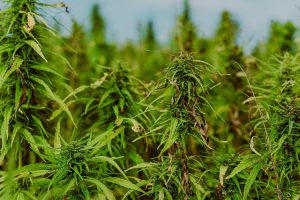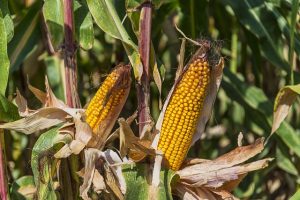
Field losses are a major problem for any farm. You directly lose out on the investment and potential profits from lost produce, while also losing valuable food that people need. According to recent studies, it seems that corn is particularly vulnerable to field losses.
The World Wildlife Fund estimates that 4.7% of corn harvests are left on the field in the US, adding up to over $2 billion dollars in lost revenue for American farmers.
This is a significant problem, and anyone who grows corn should be aware of the loss potential.
So, in this article, we’ll be looking at the most common causes of lost corn, possible solutions, and harvesting strategies that can minimize loss as well.
Common Causes of Corn Field Losses and Possible Solutions
1. Pests

Pests are the most obvious source of corn loss, and one of the most pernicious. Every farm must fight against critters and insects trying to steal their crops. In the case of corn, common threats include various species of stalk borers, grasshoppers, rootworms, weevils, and aphids. In addition, some species of birds like to snack on opportune stalks as well.
Fortunately, there are numerous strategies for fighting them:
- Insecticides are effective, but risk runoff and damage to the soil if overused.
- Crop cover plants can help prevent flying pests—such as birds and locusts—from seeing or accessing the corn.
- Crop rotation has proven effective in starving out colonies of pest insects, preventing long-term colonization.
- Predatory birds like owls and shrikes, when encouraged to live nearby, can be very effective natural pest control.
2. Diseases
Corn diseases are another major contributor to losses. Blights such as northern corn leaf blight, tar spot, and gray leaf spot can ravage a field if left unchecked. Most corn diseases are caused by fungi and can therefore be controlled with fungicides. However, as with insecticides, they should be used sparingly and only as needed.
Planting and farming strategies can also help prevent fungal outbreaks. Avoid poorly draining fields that remain moist, especially those in shady areas, as they create favourable conditions for fungi.
In addition, consider investing in a crop growth monitoring system. Agricultural cameras, strategically placed around your field, allow you to visually survey your crops day-by-day—and spot the signs of any new infections early, before they have time to spread.
3. Weeds

Weeds are another contributor to corn loss—especially if the weeds choke out young corn plants. Herbicides are the traditional solution here, but like other chemical solutions, can be harmful to your farm and the surrounding environment if overused.
Organic non-chemical methods for weed control are a subject of ongoing research. None are magic bullets, but as a few suggestions:
- Be vigilant about policing weeds in between harvests. Reduce their numbers before planting.
- Thoroughly clean farm machinery to avoid transporting weed seeds between fields.
- Consider implementing no-till planting methods since they seem to reduce the viability of weed seeds.
- Try low-to-the-ground cover crops because they may help starve out the weeds.
4. Nutrient Deficiencies
Healthy soil makes for healthy plants, and poor soil will lead to poor crops. One of the best things you can do for your corn crop is to ensure the soil is healthy and ready for corn’s growth.
Monitor your soil closely for its acidity. A pH of 6-6.5 is considered optimal for most corn breeds. Fertilizers can be used to ensure nutrition is appropriate but stick to organic fertilizer as much as possible. Synthetic fertilizers tend to increase acidity, as well as harm necessary microscopic life in the soil.
Crop rotation is another key here. It’s common to rotate between corn and soybeans, in particular. Soybeans—like all legumes—fix nitrogen on their own and add nitrogen to the soil which will then feed the corn on the next rotation.
5. Phantom Loss

Phantom loss refers to loss in crop volume while still on the field. In short, modern corn crops tend to produce bigger, plumper kernels with extra moisture inside. If that moisture is allowed to escape, the overall volume decreases. This can result in the loss of anywhere from 5-15 bushels per acre.
In response to this, it’s becoming increasingly common for farmers to harvest their corn earlier to preserve the moisture content. This does require investment in better drying and storage, however, to prevent the relatively damp corn from spoiling in storage.
Improved Harvesting Techniques
Other on-field corn loss comes from loss during harvests. This comes from losing full ears of corn before the combine has a chance to snag them, or else losing or destroying viable corn during the threshing process.
Proper configuration of the combine is essential for preventing harvest loss. The most common helpful recommendations are the following:
- Ensure the gathering snouts are as close to ground level as possible, without snagging on the ground.
- Set the snapper roll according to the size of the stalks.
- Snapper roll speed should be relatively low to prevent impacts from jarring ears loose too early.
- Stripper plates should be a bit wider in front, than in the rear, to prevent clogs.
- Cylinder speed should be as low as possible, while still capable of threshing the corn.
- Trash knives should be set near the rolls to prevent wrapping.
- Conclave clearance settings should avoid breaking up the ears too much. 3-4 pieces is optimal, helping to avoid loss due to small chunks being dislodged.
Monitoring and Awareness Are Keys to Preventing Crop Loss
The key takeaway here is that vigilance is your best asset in fighting field crop losses. Be aware of the various threats to your corn and keep a close eye out for trouble so that you can correct it quickly.
One helpful tool for improved awareness is crop growth monitoring systems, such as agri-cameras connected to data collection platforms. These systems allow you to oversee your fields from anywhere, at any time, receiving the most up-to-date information and making data-based decisions quickly. With such solutions, you can better protect the health of your crops and soil.
![]()
Author Profile

- Eco Warrior by day, Eco Blogger by night trying to get the eco balance right.
Latest entries
 Green Home GuidesApril 17, 2025How Heat Pumps Help Cut Household Carbon Emissions
Green Home GuidesApril 17, 2025How Heat Pumps Help Cut Household Carbon Emissions EnvironmentApril 17, 20256 Benefits of Wall Cladding for Eco-Friendly Renovations
EnvironmentApril 17, 20256 Benefits of Wall Cladding for Eco-Friendly Renovations EnvironmentMarch 31, 20255 Sustainable Materials for Building Your Dream Eco-Friendly Pergola
EnvironmentMarch 31, 20255 Sustainable Materials for Building Your Dream Eco-Friendly Pergola Best practicesMarch 25, 202510 Green Tips to Live a More Sustainable Lifestyle
Best practicesMarch 25, 202510 Green Tips to Live a More Sustainable Lifestyle





Leave a Reply
You must be logged in to post a comment.